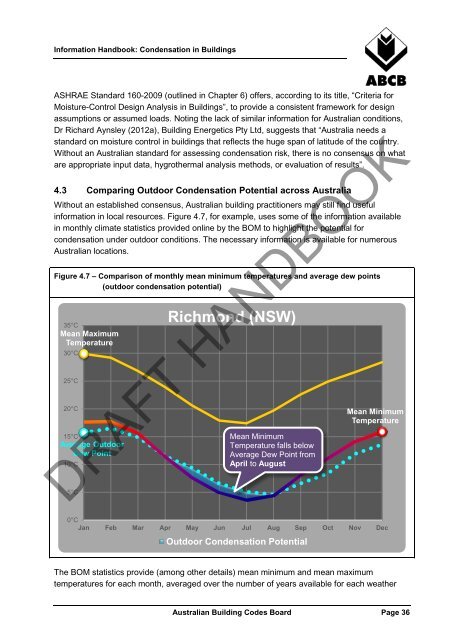Condensation in Buildings - Australian Building Codes Board
Condensation in Buildings - Australian Building Codes Board
Condensation in Buildings - Australian Building Codes Board
Create successful ePaper yourself
Turn your PDF publications into a flip-book with our unique Google optimized e-Paper software.
Information Handbook: <strong>Condensation</strong> <strong>in</strong> Build<strong>in</strong>gs<br />
ASHRAE Standard 160-2009 (outl<strong>in</strong>ed <strong>in</strong> Chapter 6) offers, accord<strong>in</strong>g to its title, “Criteria for<br />
Moisture-Control Design Analysis <strong>in</strong> Build<strong>in</strong>gs”, to provide a consistent framework for design<br />
assumptions or assumed loads. Not<strong>in</strong>g the lack of similar <strong>in</strong>formation for <strong>Australian</strong> conditions,<br />
Dr Richard Aynsley (2012a), Build<strong>in</strong>g Energetics Pty Ltd, suggests that “Australia needs a<br />
standard on moisture control <strong>in</strong> build<strong>in</strong>gs that reflects the huge span of latitude of the country.<br />
Without an <strong>Australian</strong> standard for assess<strong>in</strong>g condensation risk, there is no consensus on what<br />
are appropriate <strong>in</strong>put data, hygrothermal analysis methods, or evaluation of results”.<br />
4.3 Compar<strong>in</strong>g Outdoor <strong>Condensation</strong> Potential across Australia<br />
Without an established consensus, <strong>Australian</strong> build<strong>in</strong>g practitioners may still f<strong>in</strong>d useful<br />
<strong>in</strong>formation <strong>in</strong> local resources. Figure 4.7, for example, uses some of the <strong>in</strong>formation available<br />
<strong>in</strong> monthly climate statistics provided onl<strong>in</strong>e by the BOM to highlight the potential for<br />
condensation under outdoor conditions. The necessary <strong>in</strong>formation is available for numerous<br />
<strong>Australian</strong> locations.<br />
Figure 4.7 – Comparison of monthly mean m<strong>in</strong>imum temperatures and average dew po<strong>in</strong>ts<br />
(outdoor condensation potential)<br />
35°C<br />
Mean Maximum<br />
Temperature<br />
30°C<br />
25°C<br />
20°C<br />
15°C<br />
Average Outdoor<br />
Dew Po<strong>in</strong>t<br />
10°C<br />
5°C<br />
Richmond (NSW)<br />
Mean M<strong>in</strong>imum<br />
Temperature falls below<br />
Average Dew Po<strong>in</strong>t from<br />
April to August<br />
Mean M<strong>in</strong>imum<br />
Temperature<br />
DRAFT HANDBOOK<br />
0°C<br />
Jan Feb Mar Apr May Jun Jul Aug Sep Oct Nov Dec<br />
Outdoor <strong>Condensation</strong> Potential<br />
The BOM statistics provide (among other details) mean m<strong>in</strong>imum and mean maximum<br />
temperatures for each month, averaged over the number of years available for each weather<br />
<strong>Australian</strong> Build<strong>in</strong>g <strong>Codes</strong> <strong>Board</strong> Page 36
















